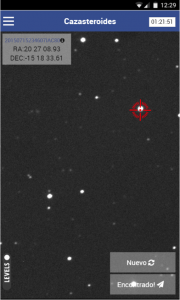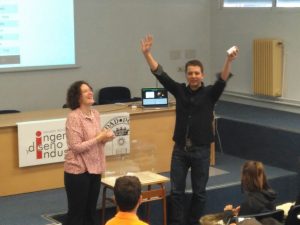Any of the 2000 potentially dangerous asteroids for Earth can impact the future against our Planet with disastrous consequences.
Cazasteroides puts at the disposal of the citizenship a tool to collaborate in the protection of the Earth against the impact of asteroids.
Currently there is a population of 750,000 asteroids and each month about 2000 new objects are discovered. About 2% of the total number of asteroids are classified as NEAs (Near-Earth Objects) and about 10% -2000 are PHAs or potentially dangerous asteroids for the Earth, that is, asteroids with a non-zero probability of impact against our planet. The Minor Planet Center of the International Astronomical Union is the body that records the asteroid database, maintained with the observations of professional astronomers and amateurs.
Researchers at the Universidad Politécnica de Madrid (UPM) and the Instituto de Astrofísica de Canarias (IAC) have developed an app that allows anyone, and in a friendly way, to help control the population of asteroids. It is a free application for mobile devices called “cazasteroides”. Being a cazasteroide is simple, it only requires having the app installed (in its Android version, iOS or in a web browser) and visual acuity. The user sees in their mobile a sequence of images of the sky and marks those objects suspected of being asteroids – they move on the fixed background of stars. The detections are first filtered by the users themselves – through a voting system – and finally it will be a team of professional astronomers that verify the true nature of the objects detected.
The application includes gamification techniques to make it more attractive to users, rewarding them with points – and virtual money – for their actions. This money can later be spent for teleoperation from the app itself of the different astronomy experiments of the GLORIA network (http://gloria-project.eu).
The final goal in the medium term is to have a worldwide network of telescopes that contribute their images and are part of this application so that, in a very fast and thanks to the collaboration of thousands of citizens, the population of dangerous objects can be controlled.
The first prototype was presented last November at the Week of Science and Innovation in the Canary Islands. Miquel Serra-Ricart, an astronomer of the IAC and responsible scientist of the app, presented the project to dozens of schoolchildren who tested the application from their own mobile devices. “The visual acuity of young people will allow us to detect weaker, and therefore smaller, asteroids than with traditional image recognition algorithms. The key is to get thousands of citizens involved in the project. It is the task of all to protect the future of our planet and hunters will be our shield against objects that come very close to the Earth “comments Serra-Ricart.
Among the days of December 22, 2016 to January 8, 2017 a more advanced version will be presented at the Children’s Park of Tenerife (PIT). Thanks to the collaboration of Media Markt Tenerife and Volkswagen Canarias, thousands of young people can become cazasteroids using Android tablets and their own mobiles.
This project has been funded by the Spanish Foundation for Science and Technology (FCT-15-10462) during the year 2016.
Follow the project on the different channels!
Web: www.cazasteroides.org
Twitter: https://twitter.com/cazasteroides
Facebook: https://www.facebook.com/cazasteroides/

Figura 1.- A screenshot of Cazasteroides (Android app).












